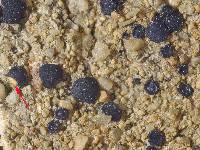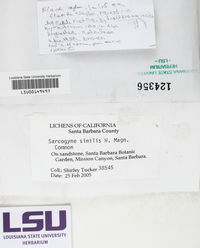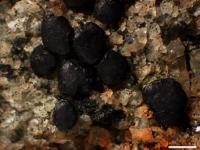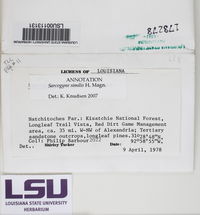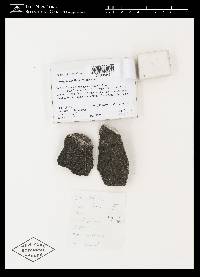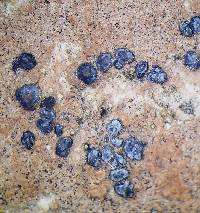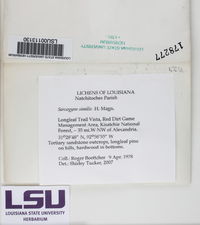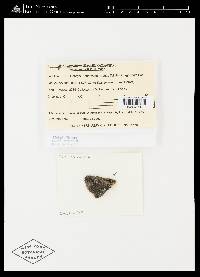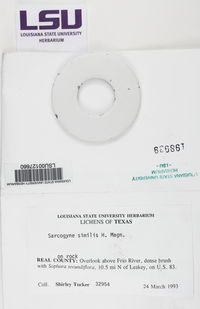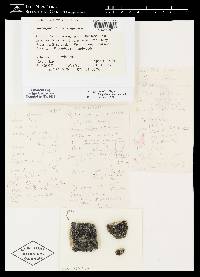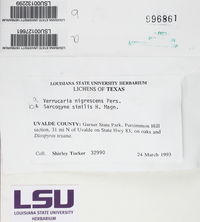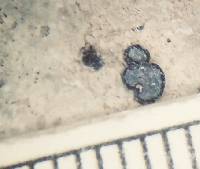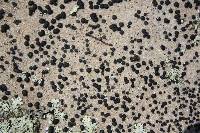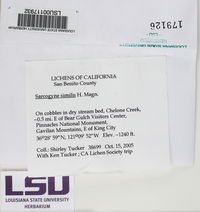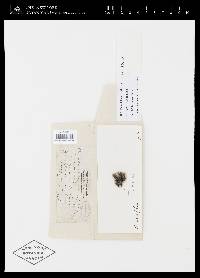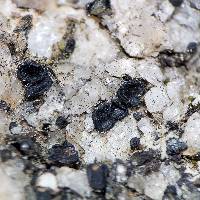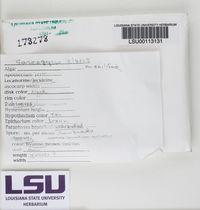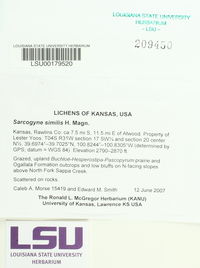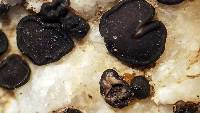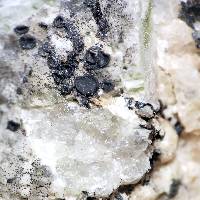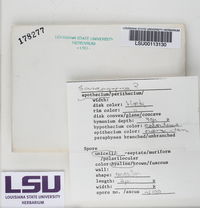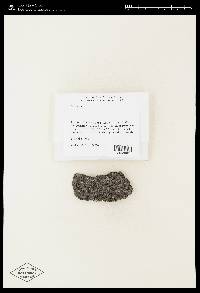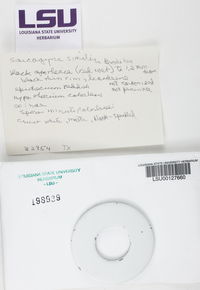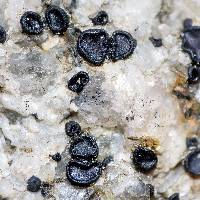
- Home
- Search
- Images
- Species Checklists
- US States: O-Z >
- US National Parks
- Central America
- South America
- US National Parks
- Southern Subpolar Region
|
|
|
|
Family: Acarosporaceae
[Biatorella similis H. Magn., moreBiatorella similis f. convexa (H. Magn.) Zahlbr., Biatorella similis f. similis H. Magn., Sarcogyne reebiae K. Knudsen] |
MB#411813 TYPE: U.S.A. California: Santa Cruz Mountains, Devil’s Cañon, 2300 ft., 8 Aug. 1906, on sandstone, A.C.W.T. Herre 948 (FH [HUH-00213645]!, lectotype designated by Knudsen & Lendemer (2005). Thallus endolithic, with scattered algal cells, spreading to several cm or more between usually dispersed apothecia, rarely epilithic on hard rock or chasmolithic on decomposed or decaying rock. Chemistry. Apothecia producing psoromic acid, in thin section P+ intense yellow, rarely needing TLC analysis. Distribution and Ecology. Common in North America (Canada, United States), in the Sonoran Desert region common in central and southern California where it is sympatric with S. californica, absent or rare in the more continental parts of the Sonoran Desert (i.e., Arizona). On siliceous rock, especially sandstone, in full sun. Occasionally chasmolithic, especially if growing on soil or on decomposed or decaying rock, where parts of the thalli become more distinctly epilithic. Reported from Greece but those specimens need to be revised. Differentiation. Sarcogyne similis is the only member of the Acarosporaceae producing psoromic acid. Sarcogyne californica and S. similis can look very similar, especially during early development. However, one can usually observe at least some distinctly convex apothecia in specimens of S. californica, even among immature apothecia, where the convex apothecial discs push the margin aside, beginning a process where the apothecia ultimately appear immarginate. Sarcogyne similis also usually only has algae at base of its apothecia, though even there these photobionts can be absent; instead the thallus embeded within the substrate has scattered clusters of algal cells. Discussion. The majority of specimens from eastern North America to the type locality in Santa Cruz County in central California are uniform in appearance. Specimens can typically be identified reliably without thin-layer chromatography by their P+ golden yellow spot test reaction, but these spot tests should be carried out by sectioning apothecia, applying the reagent directly to the microscope slide, otherwise the positive P reaction might easily be overlooked. Sarcogyne californica was previously considered a synonym in the Sonoran Flora, where Sarcogyne reebiae was described as a new species (Knudsen & Standley, 2007). Sarcogyne reebiae, however, shares the same chemistry with S. similis and must be considered conspecific (Knudsen & Kocourková 2020, Lendemer et al. 2022). Sarcogyne california lacks psoromic acid and is also phylogenetically distinct (Knudsen, in press). LITERATURE: Knudsen, K. & J. C. Lendemer (2005) Changes and additions to the checklist of North American lichens — III. Mycotaxon 93: 277–281. Knudsen, K. & Kocourková, J. (2020) Lichenological Notes 7: On taxa of Acarospora and Sarcogyne. Opuscula Philolichenum 19: 158-162. Knudsen, K. & S. M. Standley (2007) Sarcogyne. In: T. H. Nash III, C. Gries & F. Bungartz (eds.) Lichen Flora of the Greater Sonoran Desert Region. Volume III. Lichens Unlimited, Tempe, p. 289–296. Knudsen, K., Lendemer, J.C. & Harris, R.C. (2011) Studies in lichens and lichenicolous fungi – no. 15: miscellaneous notes on species from eastern North America. Opuscula Philolichenum 9: 45–75. Lendemer, J.C., Bungartz, F., Morse, C. & Manzitto-Tripp, E.A. (2022) Sarcogyne similis (Acarosporaceae) produces psoromic acid and is confirmed to be widespread in North America. The Bryologist 125(1): 91-101. Nash, T.H., Ryan, B.D., Gries, C., Bungartz, F., (eds.) 2007. Lichen Flora of the Greater Sonoran Desert Region. Vol 3. Thallus: reduced, primarily beneath the apothecia, rarely with pale epilithic areoles less 1 mm in diam. often associated with initially developing pycnidia on hard granite, or ecorticate curds of granules associated with decaying granite medulla: white, prosoplectenchymatous, continuous with attaching hyphae, interspersed with large POL+ crystals not dissolving in K algal layer: ±80 µm thick beneath the apothecia, cells up to 12 µm wide, sometimes feathering into a chasmolithic extension of thallus Apothecia: scattered, 0.2.-1 mm in diam., abundant and regular in shape, often formed from pycnidia, not vegetatively dividing disc: black (reddish black when wet), round and immersed, plane and rough, epruinose margin: black, raised, donut-like, often with shallow striations true exciple: 100 µm or more thick, composed of radiating hyphae, externally dark reddish brown, with discernible apices of hyphae, internally reddish brown lightening to yellow, interspersed with POL+ crystals obscuring the hyphae, partially dissolving in K and clearing epihymenium: black to reddish brown, 10-30 µm thick, conglutinated, uneven, with some POL- crystals on the surface hymenium: hyaline in lower two-thirds, becoming yellow to pale red in upper third, shading into the very dark epihymenium, 50-90(-100) µm tall; paraphyses: thin-walled with oil drops, septated without constrictions, basally c. 2 µm wide, apically usually not expanded, obscure and conglutinated in dark brown gel, not dissolving completely in K subhymenium: hyaline, c. 40 µm thick, composed of intricate hyphae hypothecium: hyaline to yellow-tinted, compsed of prosoplectenchyma periclinal to subhymenium, radiating into the exciple and becoming obscure, c. 20 µm thick asci: sometimes rare, cylindrical, swelling to 40-60 x 20-25 µm,100+-spored ascospores: hyaline, simple, narrowly ellipsoid, mostly 3.5-4.2 x c. 1 µm Pycnidia: black, in sessile verrucae, spherical, up to 0.5 mm in diam., preceding apothecial formation conidia: ellipsoid to globose, mostly 2-3 x 1-2 µm Spot tests: all negative Secondary metabolites: none yet detected. Substrate and ecology: on granite, in drainages, on north slopes or on sandstone World and Sonoran distribution: southern California. Note: Sarcogyne reebiae is distinguished from S. similis by its usually smaller apothecial size, its black exciple (shaped like a donut esp. in early development) raised above the disc, its plane apothecia with an intact margin, the lack of vegetatively dividing apothecia, and its apothecial ontogeny from sessile, verrucae-like pycnidia (like S. clavus). It could also be confused with S. privigna, which has a similar blackened exciple, but the apothecial margins of S. privigna, as treated here, have fused joint lines and its apothecia are not regular. The striations on the margins of S. reebiae are shallow and hence differ from the joint lines of S. privigna. At the type locality of S. reebiae, both S. privigna and S. similis also occur. In most specimens, the disc of S. reebiae when wetted remains black; while in S. privigna, such treated discs usually turns red. Sarcogyne reebiae could also be confused with S. novomexicana, but the latter species has wider paraphyses and spores, a distinctly brown margin, and a disc that turns orange to reddish orange when wet. Sarcogyne reebiae probably belongs to Sarcogyne s. str. based on the morphological analysis above. It is currently known only from southern California at low elevations with a maritime influence. CHEMISTRY NOTE: The lower hypothecium in an apothecial section of the isotype at ASU reacts with P+ golden yellow, K-. Contrary to the protologue the specimen most likely contains psoromic acid (tested by F. Bungartz, 29-Nov-2018). Nash, T.H., Ryan, B.D., Gries, C., Bungartz, F., (eds.) 2007. Lichen Flora of the Greater Sonoran Desert Region. Vol 3. Thallus: endolithic or thallus reduced to zone beneath apothecia or forming an ecorticate white to brown areolate thallus on crumbling, uneven substrates, with variable algal development Apothecia: black but sometimes with a reddish tint, round, 0.5-1(-2.1) mm in diam., dispersed or contiguous, becoming irregular when dividing to form new apothecia, sometimes forming immarginate and pulvinate clusters up to 7 mm across; broadly attached with medullary hyphae becoming thickly umbilicate disc: black (reddish black when wet), plane to convex, rough and uneven, rarely appearing gyrose, not carbonized, epruinose but the surface may appear pruinose in flush zones from particle deposition margin: black, smooth to rough, sometimes splitting and appearing crenulate, edge often down-turned over disc, disappearing if disc becomes very convex true exciple: 50-100 µm thick, externally black and tarry but not carbonized, internally brownish yellow with orange or red tones or sometimes hyaline epihymenium: yellowish to dark brown, 15-25(-30) µm thick, in a thick gel hymenium: hyaline, though sometimes orange in thick sections, (70-)80-115(-125) µm; paraphyses: conglutinated unevenly, septate, basally 1.5-2.5 µm wide, apically not expanded or 3-4 µm wide subhymenium: hyaline or pale yellow, indistinct, 15-25(-40) µm thick hypothecium: hyaline or pale yellow, 10-40 µm thick but sometimes hard to distinguish from subhymenium asci: clavate, 75-85 x 7-14(-27) µm, 100+-spored;. ascospores: hyaline, simple, variable in size, 4-6 x 1.1-2.3 µm Pycnidia: not observed Spot tests: all negative Secondary metabolites: none detected. Substrate and ecology: primarily on acidic rocks and rarely on coarse-grained alluvium from sandstone and granite or on limestone World distribution: Europe and North America Sonoran distribution: Arizona and southern California. Notes: Sarcogyne similis is similar to S. regularis but occurs on acidic rocks, and differs with its usually tar-like exciple, in having a wide dark-colored zone in its inner exciple, and in having apothecia, which divide and sometimes become convex and immarginate. Both species can vary in characteristics, leading to some specimens being hard to determine. But substrate is a good species indicator, except rarely on sandstone. Besides substrate, S. similis has irregular shaped apothecia that regularly divide and the medulla often thickens beneath the apothecium becoming umbilicate. Both species occasionally produces a thallus on crumbling substrates or sandstone. Sarcogyne.magnussonii de Lesd. (holotype missing) appears to be described from specimens of S. similis with thalli on sandstone in Mexico. Sarcogyne athroocarpa H. Magn. appears to be a reduced form of S. similis common at high elevations in Rocky Mountains. Magnusson's annotation is missing and the type is uncertain (FH!). These reduced specimens generally have a less tarry exciple. We have seen at least two probably undescribed taxa from montane habitats in Califronia and Arizona that would key out to S. similis or S. novomexicana but would not match our descriptions. Sarcogyne californica H. Magn is a synonym of S. similis which differs only in being described as always immarginate and pulvinate. The pulvinate form is caused by the multiple division of an apothecium and is very striking when seen, but intermediates with apothecia dividing into a lesser degree are numerous. Divisions forming pulvinate clusters were observed on hard granite boulders, which may stimulate it through restricting the spread of endolithic hyphae; on crumbling granite, sandstone, pebbles and small rocks, or on soil, convex and immarginate discs are usually rare. |
|
|
|





